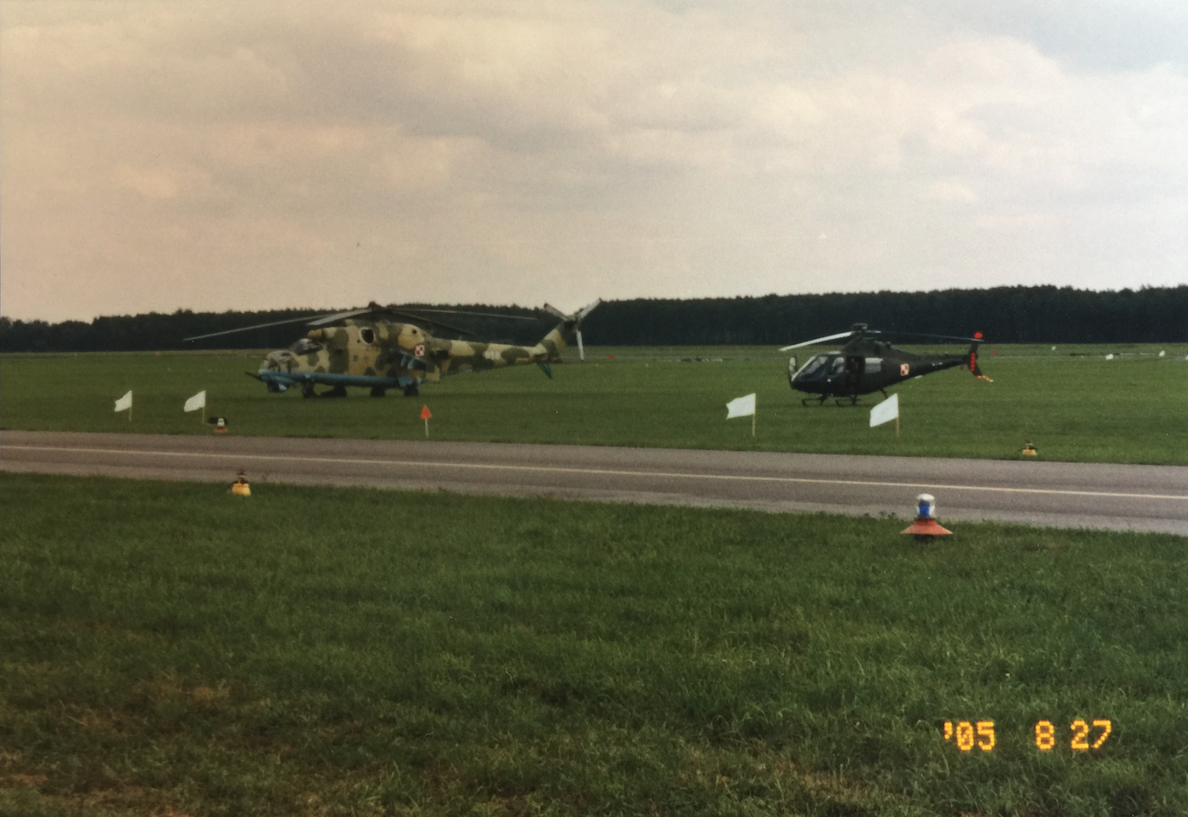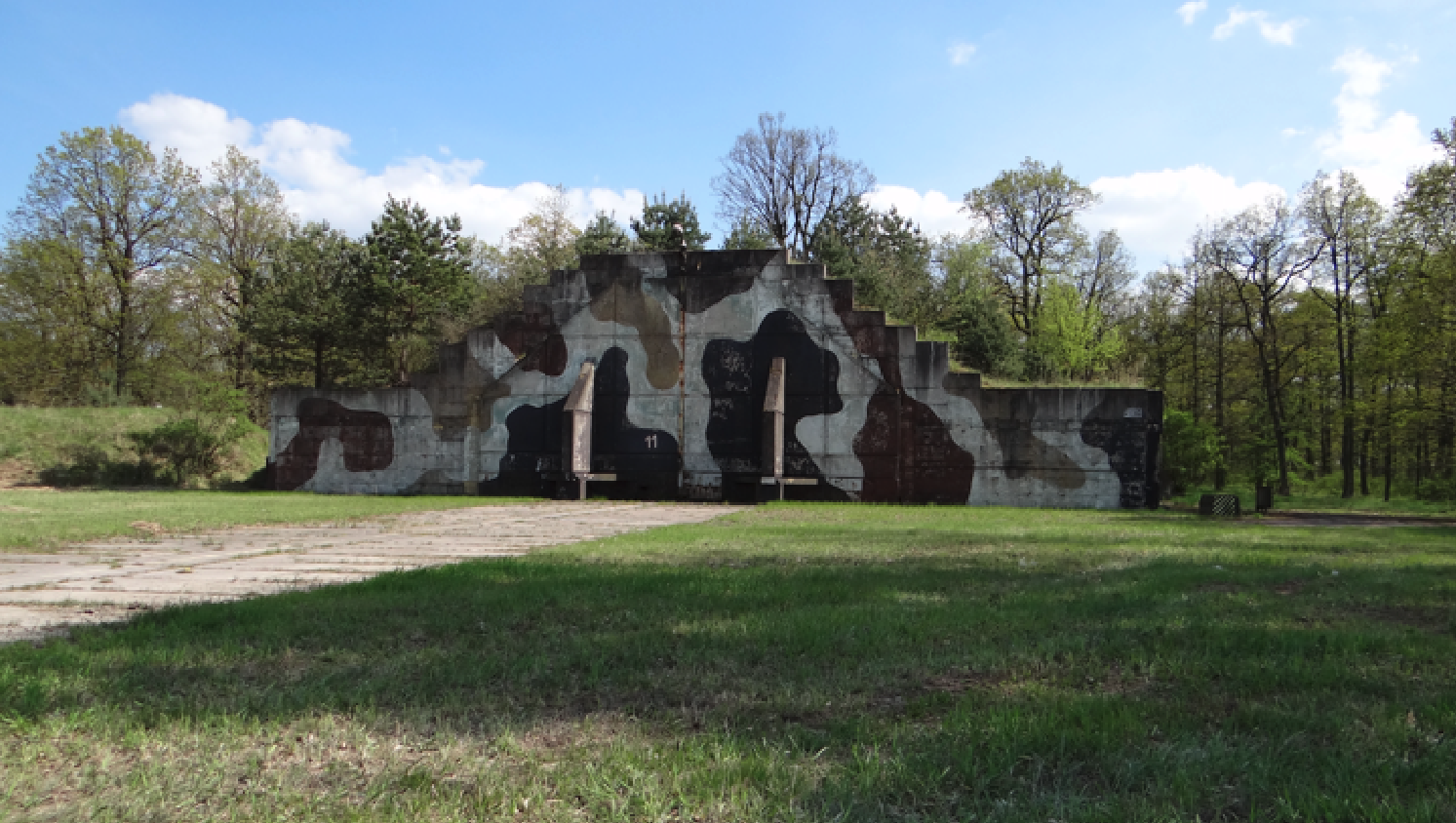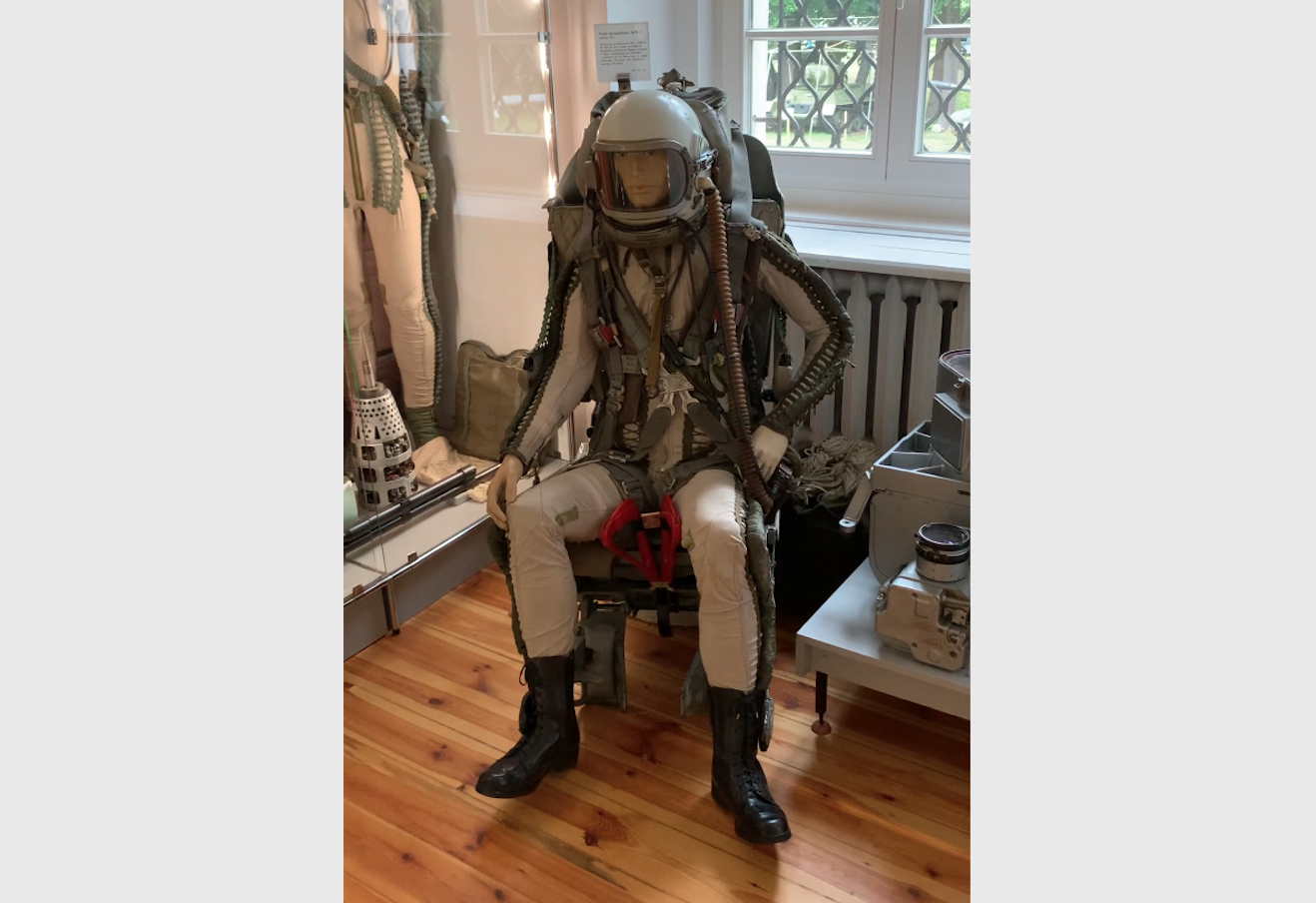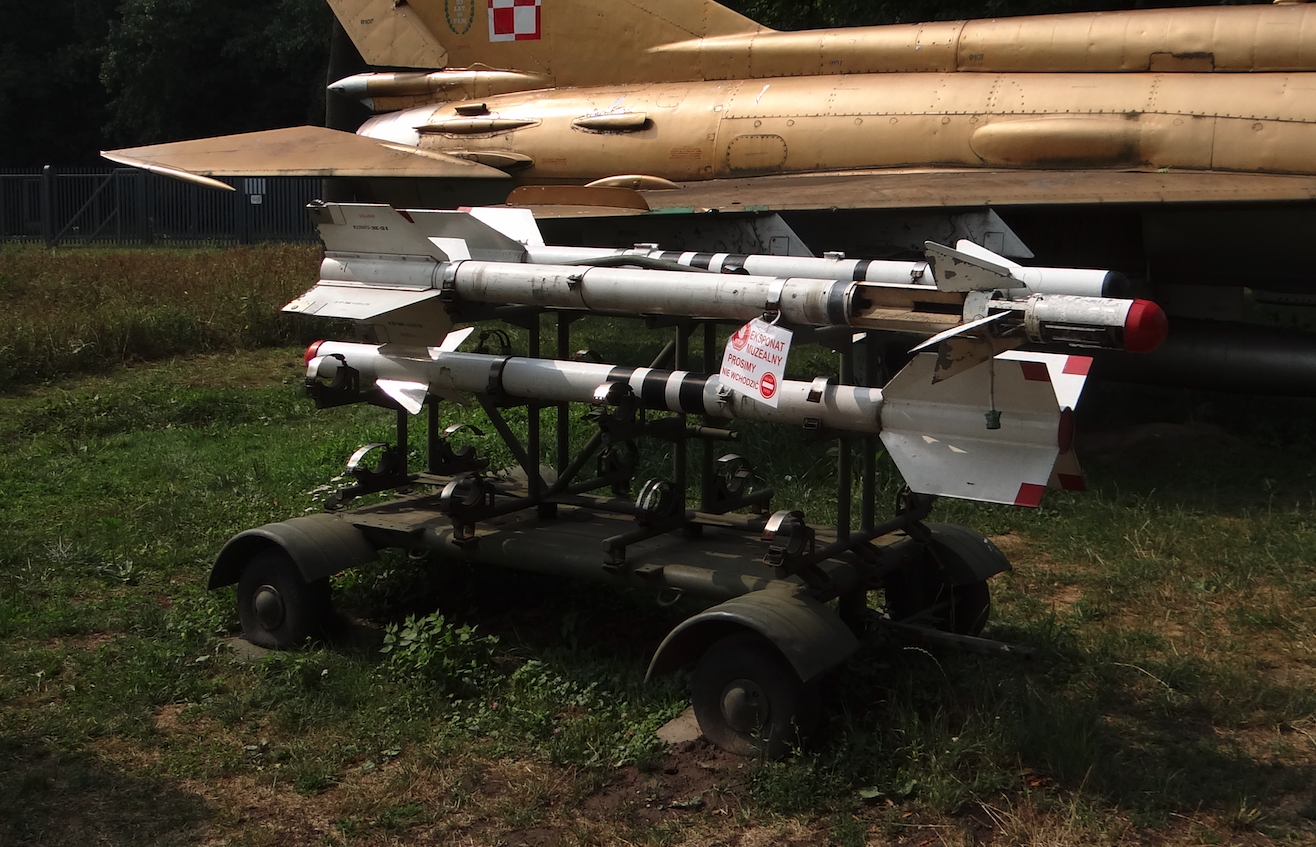Kraków 2017-08-01
Lotniska Wojskowe w Polsce Ludowej.
1945-1989.
Zaraz po zakończeniu drugiej wojny światowej przewidywano, iż lotnictwo wojskowe powróci do swoich przedwojennych baz lotniczych. Początkowe działania były nastawione na ten kierunek. Głównymi ośrodkami lotnictwa wojskowego miała być: Warszawa, Kraków, Poznań, Wrocław i Trójmiasto (Gdańsk, Sopot, Gdynia). Celem ich funkcjonowania miała być obrona najważniejszych aglomeracji miejskich.
W 1950 roku sytuacja uległa poważnej zmianie. Zaistniały trzy poważne przesłanki do dokonania tych zmian. Po pierwsze trwała wojna w Korei. Po drugie, moskwa przegrała blokadę Zachodniego berlina. Po trzecie, CCCP dokonał udanej próby atomowej (jądrowej). Podjęte wówczas na kremlu decyzje doprowadziły do rozrostu militarnego Polski ponad potrzeby obronne naszych granic. Na masową skalę rozpoczęto produkcję samolotów bojowych. Jednocześnie rozpoczęto modernizację starych lotnisk i podjęto budowę około 60 nowych lotnisk wojskowych. Część z nich miało stać się bazami dla nowo utworzonych Polskich pułków lotniczych, część miała stanowić lotniska zapasowe dla tych pułków, a w końcu kilkanaście lotnisk miało być przekazanych do dyspozycji armii sowieckiej.
100 % tych inwestycji zlokalizowano w północno-zachodniej części Polski. Lotniska lokalizowano w kompleksach leśnych, z dala od większych miast i miasteczek. Czasami wykorzystywano tereny po byłych lotniska germańskich lub tereny poligonowe.
Nazewnictwo poszczególnych lotnisk, a zwłaszcza lotnisk zapasowych nastręczało i nastręcza do dnia dzisiejszego pewne trudności. Zwykle było tak, że lotnisko otrzymywało nazwę powiatowej miejscowości na terenie której się znajdowało. Ale także mogło otrzymać nazwę miejscowości sąsiedniej, bo tam znajdowała się poczta, a ściślej urząd pocztowy i centrala telefoniczna. Dlatego dla danego lotniska mogły przypadać dwie, a czasami i trzy nazwy. Na przykład lotnisko zapasowe Konarzyny figurowało także pod nazwą Sąpolno lub Chojnice. Niemniej jednak w nomenklaturze Wojska Polskiego dla danego lotniska zawsze była jedna nazwa, i tak lotnisko Konarzyny figuruje w dokumentach jako Sąpolno. W obecnych czasach, niektóre gminy przyznają się do związków z byłymi lotniskami, co czasami przejawia się w nazewnictwie ulic. Wówczas w tych miejscowościach możemy spotkać nazwę ulicy Lotnicza lub Spadochronowa.
Sporym atutem dla budowy lotniska była bliskość linii kolejowej lub możliwość doprowadzania bocznicy kolejowej na plac budowy. Transport kolejowy był najważniejszy nie tylko w okresie budowy lotniska, ale także w trakcie jego eksploatacji. Koleją dostarczano materiały budowlane, wyposażenie koszarowców i innych budynków, wywożono wycięte drewno, dostarczano węgiel na opał, paliwa dla samolotów i samochodów, części zamienne do samolotów, uzbrojenie, przebazowywano naziemny komponent jednostki lotniczej, wysyłano do remontu silniki lotnicze, radiostacje i inny sprzęt wojskowy, a nawet dostarczano żywność dla wojska.
W 50-latach lotniska budowano według jednego podstawowego planu opracowanego w CCCP. Najważniejszym elementem lotniska, podobnie jak i dzisiaj, było pole wzlotów w kształcie prostokąta. Długość około 3 000 m, szerokość około 500 m. Zasada była taka, aby dłuższy bok tego prostokąta znajdował się na kierunku najczęstszych wiatrów. Na polu wzlotów umieszczano jedną drogę startową (RWY) o nawierzchni betonowej. Miała ona długość od 1 900 m do 2 200 m. Szerokość wynosiła 40-60 m. Równolegle, z boku wytyczano awaryjną drogę startową o nawierzchni gruntowej. Jeśli lotnisko było bazą dla ważnego pułku lotniczego, systematycznie, w czasie kolejnych remontów, drogę startową wydłużano, a nawet poszerzano. Równolegle do drogi startowej budowano główną drogę kołowania o szerokości 10-20 m, o nawierzchni betonowej, która w trzech lub czterech miejscach łączyła się drogami kołowania z drogą startową. Na obu końcach głównej drogi kołowania umieszczano płaszczyzny postoju samolotów (PPS), także o nawierzchni betonowej.
W 50-latach oświetlenie pola wzlotów było bardzo skromne. Nie kiedy nie było go wcale. Do lotów nocnych rozstawiano reflektory, a nawet wykorzystywano reflektory samochodów ciężarowych.
Podobnie skromnie było ze środkami łączności i radiolokacji. Najważniejsza była radiostacja łączności, dzięki której utrzymywano łączność między stanowiskiem kierowania lotami (Kierownik Lotów) a załogami samolotów. Wszyscy pracowali na jednej częstotliwości, dlatego komendy słyszeli wszyscy. Sprzęt radiolokacyjny na szeroką skalę pojawił się w 60-latach. Był wykorzystywany nie tylko do wykrywania przeciwnika, ale przede wszystkim do realizowania zadań taktycznych w powietrzu i podejść do lądowania.
Znaki poziome malowane na drogach startowych i kołowania były skromne. Malowano tylko centralą linię przerywaną wzdłuż całej drogi startowej oraz tak zwany celownik, który wyglądał inaczej niż obecny. Celownikiem były prostokątne pasy namalowane przy lewej krawędzi drogi startowej na kierunku podejścia, w rejonie w którym samolot powinien przyziemić. Pierwszy pas miał długość 30 m, drugi 20 m, trzeci 10 m (w miejscu idealnego przyziemienia) i ponownie 10 m, 20 m i 30 m. Tak zwana „zebra”, która wskazywała początek/koniec oraz szerokość drogi startowej, pojawiła się dopiero w 70-latach.
Na wielu nowych lotniskach budowano jeden lub dwa hangary. Służyły one głównie do wykonywania przeglądów technicznych samolotów i remontów, które wykonywano siłami jednostki. Do takich prac należała między innymi wymiana: silników, uzbrojenia, foteli katapultowanych, podwozia. Dokonywano także drobne napraw płatowców i prace lakiernicze.
W wyniku wojen na Bliskim Wschodzie i w Indochinach (60-lata) zaczęto samoloty rozśrodkowywać, czyli umieszczać je w strefach rozśrodkowania w pozornym nieładzie. Chodziło o zminimalizowania strat w sprzęcie w wyniku bezpośredniego ataku na lotnisko przez samoloty szturmowe wroga, aby jedną serią z działka nie uszkodzić wielu samolotów stojących w równych szeregach. To rozśrodkowanie powodowało, że samolot na ziemi musiał być osobnym celem dla przeciwnika. Stosunkowo szybko, indywidualne stanowiska postoju samolotów obwałowywano ziemią z trzech stron, tworząc dodatkową ochronę przed nalotem. Na lotniskach, gdzie miejsca było niewiele, na przykład Lotnisko Strachowice, stanowiska były przeznaczone dla dwóch samolotów, które rozdzielał dodatkowy wał ziemi. Na lotniskach gdzie miejsca było dużo organizowano dwie, a nawet trzy strefy rozśrodkowania. Już z końcem 60-lat pojawiły się pierwsze schrono-hangary, czyli indywidualne ukrycia dla samolotów. W założeniu miały one ochronić samolot nie tylko przed konwencjonalnym atakiem, ale także przed atakiem atomowym (jądrowym).
Kolejnym ważnym elementem lotniska był skład materiałów pędnych i samarów, zwany w skrócie MPS (materiały pędne i smary). Obiekt lokowano przy bocznicy kolejowej, na skraju lotniska. MPS były obiektami, które miały własną specyfikę i niezależność. Zawsze były dodatkowo ogrodzone, z własnymi bramami dla samochodów i pociągów. Miały posterunki wartownicze funkcjonujące dzień i noc. Własny system obrony przeciwpożarowej. Wyznaczone tylko jedno miejsce jako palarnia, dla osób palących papierosy. Własny park auto-cystern i przyczep-cystern z dystrybutorami paliwa. Stacje pomp i rurociągów. Zbiorniki naziemne, umieszczone w głębokich wykopach i zbiorniki podziemne, bardziej odporne na atak przeciwnika. I wreszcie MPS miał własne laboratorium chemiczne, gdzie dokonywano standardowych badań jakościowych paliw, olejów i smarów.
Każde lotnisko bojowego pułku lotniczego posiadało własny bomboskład, czyli arsenał. Obiekt lokowano poza terenem lotniska, nawet w odległości kilku kilometrów. Zwykle był dobrze ukryty w lesie. Składał się z kilku obiektów-bunkrów w których składowano naboje do działek i karabinów lotniczych, różnego rodzaju bomby lotnicze, niekierowane pociski rakietowe i kierowane pociski rakietowe. Obiekt był ogrodzony podwójnym, kolczastym ogrodzeniem i miał stałą wartę w dzień i w nocy. Na terenie był także budynek socjalny dla warty i obsługi składu. Wraz z wprowadzeniem na uzbrojenie samolotów kierowanych pocisków rakietowych na terenie lotniska pojawił się nowy obiekt zwany stanowiskiem przygotowania i elaboracji rakiet.
Pozostała infrastruktura bazy zależała od znaczenia pułku w systemie obrony Polski i działań zaczepnych Układu Warszawskiego (zawartego w 1955 roku). Do standardowych obiektów zaplecza jednostki zaliczano: koszarowice, sztab pułku (często w tym samym budynku), kuchnię i stołówkę, kantynę (żołnierską i oficerską), wartownię, park samochodowy z garażami i warsztatem, WAK (wojskową administrację koszar), łaźnię, kotłownię, magazyny i wiaty magazynowe. Często jednostka posiadała własne gospodarstwo rolne z ogrodem warzywnym i chlewnią.
W teorii, każde lotnisko było ogrodzone stałym ogrodzeniem, drutem kolczastym lub metalową siatką. Słupki zwykle były betonowe. W rzeczywistości wiele lotnisk, zwłaszcza zapasowych, nie posiadało kompletnego ogrodzenia. A i „dziur” w ogrodzeniu było wiele, przez które to żołnierze służby zasadniczej wychodzili „na lewiznę”, czyli bez wiedzy przełożonych: na wiejską zabawę, do dziewczyny, po alkohol, itp.
Osiedle oficerskie to osiedle mieszkalne złożone z kilku/kilkunastu bloków w których mieszkali żołnierze zawodowi z rodzinami. Żołnierze zawodowi kawalerowie zamieszkiwali w hotelach na terenie osiedla. Osiedla oficerskie zwykle były zlokalizowane kilka/kilkanaście kilometrów od lotniska i często miały charakter małego miasteczka, ze sklepami, obiektami sportowymi, przedszkolem, a także często szkołą. Z tych obiektów korzystali także mieszkańcy pobliskich wiosek. Tak wyglądały osiedla oficerskie w Zielonych Garnizonach. W pułkach zlokalizowanych w pobliżu większych miast żołnierze zawodowi mieszkali w blokach wojskowych na terenie miasta.
Lotniska zapasowe.
Z uwagi na to, że gospodarka narodowa nie była w stanie zaspokoić wszystkich żądań moskwy, dlatego Wojsko Polskie uzyskano zezwolenie na formowanie dywizji lotniczych w silne dwóch, a nie trzech pułków lotniczych. W efekcie kilkanaście nowych lotnisk nie miało stałego gospodarza i w rzeczywistości otrzymały status lotnisk zapasowych dla konkretnych pułków lotniczych. W efekcie sztab dywizji lokowano w najlepszym możliwie miejscu, czyli w pobliżu dużego miasta. Tam także lokowano jeden z pułków lotniczych. Drugi pułk lokowano na drugim lotnisku, a najbardziej odległe od cywilizacji lotnisko mianowano zapasowym.
W okresie PRL lotniska zapasowe określano także jako polowe lub lotniska przebazowania. Nazwa lotnisko polowe zachowała się najdłużej na tych lotniskach gdzie nie było utwardzonej drogi startowej, jak na przykład na lotnisku Jawor. Nazwa lotnisko przebazowania odpowiadała funkcji lotniska, kiedy to w sytuacji zagrożenia i czekających go zadań, dany pułk miał przebazować się bliżej lub dalej od frontu. W trakcie drugiej wojny światowej sowieci bardzo często używali określenia – „Pułk przebazowano na lotnisko bliżej frontu”, czyli lotnisko przebazowania. Natomiast nazwa lotnisko zapasowe jest najbliższą funkcji, jaką pełniło faktycznie dane lotnisko w okresie PRL-u.
W 60-latach praktycznie wszystkie samoloty bojowe musiały już korzystać z utwardzonych dróg startowych. Chociaż możliwości operowania z gruntu zachowały samoloty PZL Lim-5 (MiG-17), a nawet Su-7 BKL (BKŁ). Jednak liczne możliwe awarie zespołów napędowych (zassanie ciał obcych do silnika), jak i możliwe uszkodzenie podwozia skłaniało do korzystania z twardych dróg startowych lub drogowych odcinków lotniskowych (DOL).
Początkowo pole wzlotów lotniska zapasowego nie różniło się od pola wzlotów lotniska podstawowego. Dopiero od 70-lat lotniska podstawowe otrzymywały stałe oświetlenie i stałe urządzenia radiotechniczne. Natomiast lotniska zapasowe pozostawały z rozwijanymi systemami oświetlenia, łączności i radiolokacji.
Lotniska zapasowe ciągle miały słabe zaplecze socjalne. Na ich terenie było niewiele stałych budynków. Żołnierze często byli kwaterowani w namiotach, korzystali z polowej kuchni i polowej łaźni. Żołnierze zawodowi kwaterowali u pobliskich gospodarzy. Lotnisko tętniło życiem tylko w okresie ćwiczeń. Z końcem 60-lat na niektórych lotniskach zapasowych wybudowano dojść dobre zaplecze socjalne, zwykle w postaci budynku wielofunkcyjnego (koszarowiec, dowództwo, kuchnia, stołówka). Wybudowano także wiaty garażowe i magazyny. Obsługa takiego lotniska była już całoroczna.
Na lotniskach zapasowych funkcjonowała Komenda Lotniska Zapasowego w skrócie KLZ. To na niej spoczywał obowiązek utrzymania lotniska. Na czele stał dowódca w stopniu oficera, który miał do pomocy szefa plutonu, nie zawsze żołnierza zawodowego. Czasami byli to podchorążowie odbywający roczną służbę wojskową po zakończonych studiach cywilnych. Resztę plutonu KLZ stanowili żołnierze służby zasadniczej, delegowani z macierzystego pułku na okres około sześciu miesięcy. Były tak zwane podmianki, czyli zastępowanie „starych” żołnierzy „młodszymi”. Niektórym udawało się odsłużyć niemal całą służbę na lotnisku zapasowym, co miało swoje dobre strony. W skład plutonu KLZ wchodzili żołnierze obsługi naziemnej wszystkich specjalności. Pluton KLZ potrafił być bardzo rozbudowany, jeśli w skład lotniska zapasowego wchodził MPS (skład materiałów pędnych i smarów) oraz bombo-skład (arsenał). W dyspozycji KLZ znajdował się podstawowy sprzęt umożliwiających przyjęcie i obsługę kilku samolotów. Kiedy przebazowany był cały pułk, za samolotami podążał rzut kołowy ze sprzętem i obsługą dla pozostałych samolotów. Dwa razy w roku, jesienią i wiosną, w trakcie tak zwanych „przejść” cały sprzęt będący w dyspozycji KLZ był konserwowany. Przy specjalności płatowca i silnika były podstawowe narzędzia, wodzidła, drabinki, podnośniki, itp. Sprzęt ten był składowany na przyczepach z plandekami.
Nieliczne lotniska zapasowe były wykorzystywane wspólnie przez żołnierzy Wojska Polskiego i armii radzieckiej. Ale nie w tym samym czasie. Deklarowana przyjaźń Polsko-sowiecka była czystą fikcją. Polski żołnierz nigdy sałdata nie traktował jako sprzymierzeńca. Trudno było zapomnieć 17 wrzesień 1939 roku, zapomnieć o zagarnięciu 1/3 Rzeczypospolitej, zapomnieć o gwałconych, okaleczanych (oślepianych, aby nie rozpoznały sprawców), a także mordowanych Polskich kobietach w 1944-1945 roku. Zainteresowanych odsyłam do publikacji „Polowanie na Białych Polaków” prof. Grzegorz Motyka.
Znany jest przynajmniej jeden przypadek, kiedy Polski pilot wylądował samolotem MiG-21 na niewłaściwym lotnisku zapasowym. Podczas dobiegu użył spadochronu hamującego, który odrzucił zjeżdżając z drogi startowej. Coś mu nie pasowało, bo samoloty na pobliskiej stojance były trochę inne. Dostrzegł czerwone gwiazdy, wykonał zwrot o 180 stopni, wykołował na drogę startową i odleciał. W niecałe pięć minut później usiadł na właściwym lotnisku zapasowym i pewnie sprawa nie ujrzałaby światła dziennego, gdyby nie ten odrzucony spadochron hamujący.
Okres świetności lotnisk zapasowych to 60/70-lata. Wówczas to Wojsko Polskie dysponowało około: 350 samolotami Lim-1, 500 samolotami Lim-2, 400 samolotami Lim-5/6 bis, 30 samolotami MiG-19, 400 samolotami MiG-21 (różnych typów) i 150 samolotów Ił-28.
Drogowe Odcinki Lotniskowe (DOL)
Pierwsze drogowe odcinki lotniskowe na świecie powstały pod koniec drugiej wojny światowej. Germańcy w swojej desperacji zaczęli wykorzystywać odcinki autostrad, jako tymczasowe lotniska. Tak rozwinął się system Reichsautobahn, który jednak nie pomógł zwycięsko zakończyć wojny, a nawet zachować granice z marca 1938 roku (aneksja Austrii). Początkowo DOL poszły w zapomnienie. Jednak agresywna postawa moskwy doprowadziła do rozgorzenia zimnej wojny. W 50-latach, po obu stronach żelaznej kurtyny system DOL był rozwijany. W Europie były to następujące kraje: NRD, Polska, Czechosłowacja, RFN, Szwajcaria.
Również z systemu DOL korzystały państwa Skandynawskie, ale tam wynikało to ze specyfiki klimatu i częściowo politycznej neutralności: Szwecja, Finlandia. Poza Europą z DOL korzystały: Korea Północna (KRLD), Tajwan, Pakistan. Na masową skalę z DOL korzystał Iran i Irak (90-lata XX wieku).
W Polsce, kolejne typy samolotów bojowych wymagały coraz dłuższych dróg startowych, o coraz większych wymaganiach, co do nośności nawierzchni. Coraz trudniej było je użytkować na lotniskach z gruntowymi polami wzlotu. Z drugiej strony, coraz bardziej rozwinięte bazy lotnicze były doskonałym celem dla przeciwnika. Skuteczny atak na te bazy doprowadziłby do unieruchomienia samolotów na nim bazujących.
Dlatego z końcem 50-lat zrodziła się koncepcja wykorzystania dróg publicznych, jako dróg startowych. Koncepcja zyskała aprobatę MON. Wytypowano około 30 lokalizacji, które można byłoby przekształcić w DOL. Ponieważ wojsko o wszystkim decydowało, nie zasięgano żadnej opinii lokalnych rad narodowych. Jest to o tyle istotne, że na czas wykonywania lotów z DOL dany odcinek drogi krajowej lub wojewódzkiej był całkowicie wyłączany z ruchu publicznego, co prowadziło do trudności komunikacyjnych.Tak jak w przypadku nowych lotnisk, tak samo i w przypadku DOL wszystkie obiekty zlokalizowano w północno-zachodniej części kraju. Typowano drogi wojewódzkie i drogi krajowe. Nie brano pod uwagę dróg powiatowych, ponieważ są one wąskie, kręte i zwykle miały gorszą nawierzchnię. Unikano skrzyżowań drogowych, przejazdów kolejowych, mostów, napowietrznych linii energetycznych i telefonicznych. Wybierano tereny zalesione, ale także nie gardzono obszarami typowo rolniczymi. Niektóre lokalizacje znalazły się na dawnych germańskich szlakach komunikacyjnych na kierunku wschód-zachód, które w Polskiej rzeczywistości nie miały tak dużego znaczenia. Przy lokalizacji DOL mniej zawracano uwagę na typowy w Polsce kierunek wiatrów wschód-zachód. Wynikało to z osłony drogi przed wiatrami poprzez pobliskie tereny leśne.
DOL technicznie nie jest skomplikowaną budowlą i z lotniczego lub satelitarnego rozpoznania jest trudny do zlokalizowania. Długość DOL wynosi od 2 000 m do 2 300 m. Szerokość od 15 m do 30 m, chociaż typowe były 20 metrowe. Na obu końcach takiego odcinka zlokalizowano płaszczyzny postoju i obsługi samolotów. Wymiary tych płaszczyzn są bardzo różne, ale przeważnie mają długość 100 m, a szerokość 50 m.
Samoloty typu Lim-2 i Lim-5 oraz wszystkie pochodne były pierwszymi samolotami myśliwskimi, które korzystały z DOL.Lecz prawdziwa rewolucja nastąpiła w chwili kiedy z DOL zaczęły korzystać samoloty typu MiG-21. Według dostępnych informacji, pierwszym pilotem, który wykonał start i lądowanie korzystając z DOL był kapitan Zbigniew Biedrzycki z 4. PLM w Goleniowie. Był to 1965 lub 1966 rok. Do operacji z DOL zawsze typowano najlepszych i najbardziej doświadczonych pilotów. Do końca 60-lat wszystkie Pułki miały przynajmniej kilku pilotów z uprawnieniami do operacji na DOL. Loty wykonywano na różnych typach samolotów MiG-21. Według informacji dostępnych w Muzeum Sił Powietrznych w Dęblinie, także samoloty Su-7 korzystały z DOL. Kolejne maszyny, których piloci także uzyskali uprawnienia do operacji z tego typu lądowisk, to Su-20 i Su-22, a także MiG-23 oraz MiG-21 bis. W 90-latach, jeszcze przed wstąpieniem Polski do NATO, na DOL na terenie Polski, loty wykonywali piloci z UK (samoloty Jaguar i Tornado), Szwecji (JA.37 Viggen), RFN (Tornado), Włochy (AMX International) i inni.
W Polsce, po przemianach ustrojowych w 1989 roku, Wojsko Polskie chciało zachować DOL i możliwość korzystania z nich. Problemem okazał się jednak wybór nowego wielozadaniowego samolotu bojowego. Samolot Lockheed F-16 Jastrząb nie ma zdolności korzystania z DOL. Natomiast JAS.39 Grippen taką zdolność posiadał, co było jednym z ważnych argumentów dla przyjęcia oferty Szwedzkiej.
Do chwili obecnej (2017 rok) zdolność korzystania z DOL zachowały samoloty MiG-29 i Su-22, które ćwiczą na DOL Kliniska. Jednak ostatnie odnotowane tam ćwiczenia odbyły się w 2006 roku.
Według informacji z dowództwa Polskich Sił Powietrznych, po wstąpieniu do NATO wytypowano jeszcze kilka potencjalnych DOL, ale chronione są jako informacje niejawne. Można tylko się domyślać, że zostały one wytypowane we wschodniej części Rzeczypospolitej. Problem w tym, że musiałyby one być zdolne do przyjmowania samolotów Lockheed F-16 Jastrząb, a to wymaga większych nakładów finansowych. Nie ulega wątpliwości, iż z ponad 25 drogowych odcinków lotniskowych do użytku obecnie nadaje się zaledwie kilka. Około pięciu. Ministerstwo Obrony Narodowej przyznaje, że wiele DOL straciły swój charakter. Musimy jednak pamietać, że MON nigdy oficjalnie nie zrezygnowało z takich lądowisk. W tym temacie wiele złego, w ostatnich 25 latach, zrobiły masońsko-liberalno-postkomunistyczne rządy, które jawnie dążyły do osłabiania Wojska Polskiego.
Sporym problemem Polskich odcinków drogowych jest także zbyt mała szerokość dostępnych DOL. Według nieoficjalnych informacji, powinny one mieć szerokość 30 m i więcej. Wszyscy piloci, którzy lądowali na DOL o szerokości 20 metrów twierdzili, że „To lądowanie na sznurowadle. Zbliżasz się, a droga jak była wąska, tak dalej jest wąska. To był spory stres. Marginesu błędu nie było, bo wypadnięcie na bok z drogi to katastrofa. Ale jest to umiejętność do opanowania.” RWY na lotnisku to szerokość 40-60 metrów.
Obecnie (2017 rok) wiele krajów na świecie i w Europie zachowuje możliwość wykorzystywania dróg publicznych do obsługi samolotów, zwykle ciężkiego transportu wojskowego. Noszą one nazwę angielską Highway strip. Drogi są tak zbudowane, iż środkowy pas, który zwykle rozdziela dwie jezdnie, jest także betonowy (asfalto-betonowy) i bariery tam zamontowane można stosunkowo szybko rozebrać. Przygotowanie tego typu lądowiska zajmuje około 24-48 godzin. Długość takiego odcinka wynosi 2 500 – 3 500 metrów. Na obu końcach znajdują się płaszczyzny postojowe, które zwykle są parkingami (MOP – miejsce obsługi podróżnych). Tego typu DOL mają być wykorzystywane nie tylko w czasie wojny, ale także w sytuacji klęsk żywiołowych i innych kataklizmów. Tego typu filozofię prowadzi na przykład Australia.
Po inwazji Tureckiej na Cypr, w 1974 roku, w greckiej części Cypru zbudowano trzy DOL na autostradach. Sa one łatwo rozpoznawalne po specyficznej środkowej linii oraz oznaczeniach tak zwanych celowników, czyli strefy dotykowej. Jeden położony jest na autostradzie Limassol-Nicosia (5 200 m, 17 100 ft), drugi na autostradzie Limassol-Larnaca (5 000 m, 16 000 ft), trzeci to znacznie mniejszy pas położony na autostradzie Limassol-Paphos w pobliżu międzynarodowego lotniska w Pafos.
Finlandia była tym krajem, który z powodu swojej specyfiki, starty samolotów z dróg publicznych i zamarzniętych jezior stosował już w okresie zimowej wojny z zarazą moskiewską już w 1939-1940 roku. Z początkiem nowego wieku, w doktrynie obronnej Finlandii pojawiła się na nowo potrzeba, aby wszystkie samoloty sił powietrznych mogły korzystać z dróg. W 2015 roku i 2016 roku Finlandia przeprowadziła manewry sił powietrznych, z udziałem Szwecji, podczas których wszystkie samoloty operowały z dróg publicznych. Podobne rozwiązania stosuje Szwecja, nieprzerwanie od 1940 roku. Pierwsze drogowe odcinki lotniskowe w Szwecji powstały około 1949 roku. Miały one długość 1 500 metrów. Sześcio-dniowa wojna na Bliskim Wschodzie dały asumpt dla Szwecji dla rozwoju sieci takich lądowisk. Samolot wielozadaniowy AJ.37 Viggen został zaprojektowany specjalnie dla korzystania z vägbas, dosłownie oznaczające „bazy dróg”. Podobnie projektowano kolejne myśliwce. W ostatnich piętnastu latach Szwecja ograniczyła korzystanie z DOL, ale odbywa wspólne ćwiczenia z Finlandią od 2015 roku) korzystając z drogowych odcinków.
W byłym CCCP istniało wiele Аэродромный Участок Дороги. Na obecną chwilę (2017 rok) trudno jest wykazać, czy siły powietrzne państwa moskiewskiego korzystają z DOL.
Opracował Karol Placha Hetman




